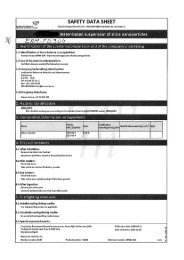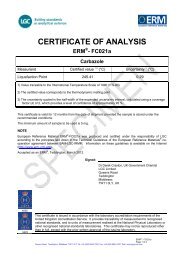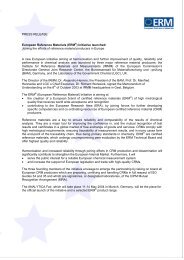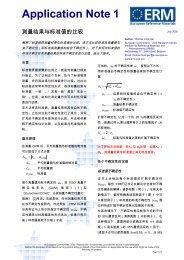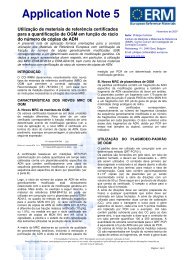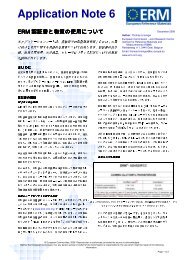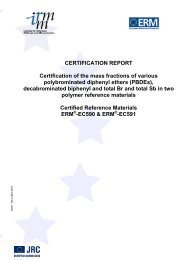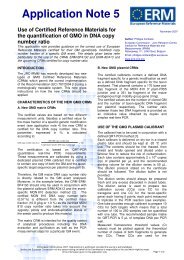Certification Report Certified Reference Material ERM - European ...
Certification Report Certified Reference Material ERM - European ...
Certification Report Certified Reference Material ERM - European ...
Create successful ePaper yourself
Turn your PDF publications into a flip-book with our unique Google optimized e-Paper software.
in cooperation with the WG ’Precious Metals’<br />
of the Committee of Chemists of GDMB<br />
<strong>Certification</strong> <strong>Report</strong><br />
<strong>Certified</strong> <strong>Reference</strong> <strong>Material</strong><br />
<strong>ERM</strong> ® -EZ505<br />
Electronic Scrap<br />
January 2011
Coordinator: Dr. Sebastian Recknagel<br />
BAM Federal Institute for <strong>Material</strong>s Research and Testing<br />
Richard-Willstätter-Straße 11<br />
12489 Berlin<br />
Tel.: ++49/30/8104 1111<br />
Fax.: ++49/30/8104 1117<br />
Email: sebastian.recknagel@bam.de<br />
Working Group „Metal Analysis; Inorganic <strong>Reference</strong> <strong>Material</strong>s“<br />
2
Summary<br />
This report describes preparation, analysis and certification of the electronic scrap reference<br />
material <strong>ERM</strong> ® -EZ505.<br />
The certified reference material can be used for chemical analysis of minor elements and<br />
traces in similar materials. It is intended for development, validation and quality control of<br />
analytical methods and procedures.<br />
<strong>Certified</strong> reference material <strong>ERM</strong> ® -EZ505 is available as powder with a particle size<br />
< 150 µm.<br />
The following mass fractions and uncertainties have been certified:<br />
Element Mass fraction Uncertainty<br />
in % in %<br />
Cu 15.10 0.11<br />
Ni 0.470 0.008<br />
in mg/kg in mg/kg<br />
Ag 692 13<br />
Au 292 4<br />
Be 68.8 2.3<br />
In 91 7<br />
Pd 90.5 2.4<br />
Pt 8.5 0.8<br />
This report contains detailed information on the preparation of the CRM as well as on<br />
homogeneity investigations and on the analytical methods used for certification analysis.<br />
The certified values are based on the results of 19 laboratories which participated in the<br />
certification interlaboratory comparison.<br />
3
Content<br />
1. Introduction ........................................................................................................................6<br />
2. Companies/laboratories involved........................................................................................6<br />
3. Candidate material .............................................................................................................7<br />
4. Homogeneity testing...........................................................................................................7<br />
5. Stability...............................................................................................................................9<br />
6. <strong>Certification</strong> study...............................................................................................................9<br />
4<br />
Page<br />
6.1 Analytical methods....................................................................................................... 9<br />
6.2 Analytical results and statistical evaluation .................................................................14<br />
7. Instructions for users........................................................................................................27<br />
8. Literature..........................................................................................................................27<br />
9. Information on and purchase of the CRM.........................................................................27
List of abbreviations<br />
(if not explained elsewhere)<br />
CRM certified reference material<br />
<strong>ERM</strong> <strong>European</strong> reference material<br />
ETAAS electrothermal atomic absorption spectrometry<br />
FAAS flame atomic absorption spectrometry<br />
ICP-MS inductively coupled plasma mass spectrometry<br />
ICP-OES inductively coupled plasma optical emission spectrometry<br />
M arithmetic mean of means<br />
n number of accepted data sets<br />
NAA neutron activation analysis<br />
SD standard deviation of an individual data set<br />
SDM<br />
standard deviation of the mean of means<br />
5
1. Introduction<br />
Printed circuit boards are a source for precious metals of economic interest. The price for<br />
used printed circuit boards is related to their precious metals content and on the current<br />
price for metals like silver, gold, platinum and palladium. Resulting from the high price for<br />
precious metals, an accurate determination of these elements is necessary. To ensure this,<br />
certified reference materials either for calibration and quality control are required.<br />
The idea to produce a reference material based on electronic scrap is the outcome of the<br />
discussions within the German Gesellschaft für Bergbau, Metallurgie, Rohstoff- und<br />
Umwelttechnik (GDMB) and especially the working group „precious metals“ of the committee<br />
of chemists within GDMB. From this working group the needs are defined, since the<br />
members are potential users of the prepared CRMs. Secondly from this group the<br />
participating laboratories are recruited. Since all of these laboratories are highly experienced<br />
with precious metals analysis there was no preceding round robin test for qualification. Most<br />
of the participants had an accreditation or a certification according to ISO 17025 or 9001.<br />
<strong>Certification</strong> of reference materials is carried out on the basis of the relevant ISO-Guides [1-<br />
3], the „Guidelines for the production of BAM <strong>Reference</strong> <strong>Material</strong>s“ [4] and the “Technical<br />
Guidelines for the Production and Acceptance of a <strong>European</strong> <strong>Reference</strong> <strong>Material</strong>” [5].<br />
Starting material for the preparation of CRM <strong>ERM</strong> ® -EZ505 were approx. 40 kg of used mixed<br />
printed circuit boards.<br />
2. Companies/laboratories involved<br />
Preparation of the material:<br />
− G + S Gesellschaft für Labortechnik und Probenaufbereitung mbH<br />
Test for homogeneity:<br />
− Allgemeine Gold- und Silberscheideanstalt AG<br />
− W.C. Heraeus GmbH<br />
− Institut für <strong>Material</strong>prüfung Glörfeld GmbH<br />
− BAM Bundesanstalt für <strong>Material</strong>forschung und -prüfung<br />
Participants in the certification interlaboratory comparison:<br />
− Alfred Knight Int. Ltd, St. Helens (United Kingdom)<br />
− Allgemeine Gold- und Silberscheideanstalt AG, Pforzheim (Germany)<br />
− AMI Doduco GmbH, Pforzheim (Germany)<br />
− Aurubis AG, Hamburg (Germany)<br />
− BAM Bundesanstalt für <strong>Material</strong>forschung und -prüfung, Berlin (Germany)<br />
− Forschungsinstitut Edelmetalle & Metallchemie, Schwäbisch Gmünd (Germany)<br />
− Horiba Scientific, Unterhaching, (Germany)<br />
− Inspectorate International Ltd, Reno NV (United States)<br />
− Inspectorate International Ltd, Witham (United Kingdom)<br />
− Institut für <strong>Material</strong>prüfung Glörfeld GmbH, Willich (Germany)<br />
− Ledoux & Company, Teanec NJ (United States)<br />
− Nickelhütte Aue GmbH, Aue (Germany)<br />
6
− SAXONIA Edelmetallrecycling GmbH, Halsbrücke (Germany)<br />
− Umicore AG & Co. KG, Hanau (Germany)<br />
− Umicore Precious Metals, Hoboken (Belgium)<br />
− Varian, Darmstadt (Germany)<br />
− W.C. Heraeus GmbH, Hanau (Germany)<br />
− Wieland Edelmetalle GmbH & Co, Pforzheim (Germany)<br />
− WRC World Resources Company GmbH, Wurzen (Germany)<br />
Statistical evaluation of the data<br />
− BAM Bundesanstalt für <strong>Material</strong>forschung und -prüfung, Berlin<br />
3. Candidate material<br />
Approx. 40 kg of used mixed printed circuit boards were taken as initial material. These<br />
boards were doped with Be, In and Pt, ashed and melted with approx. 40 kg of pyrite (FeS2).<br />
After milling and grinding the material was sieved to a particle size below 150 µm and<br />
homogenised thoroughly. The material was then bottled in 200 ml amber glass containers<br />
each filled with 200 g of material. The bottles were sealed with screw caps equipped with PE<br />
insert and with shrinking foil. In total 250 bottles were filled.<br />
4. Homogeneity testing<br />
Three laboratories performed analyses for homogeneity testing. Each laboratory received<br />
five randomly chose bottles (Table 1). The laboratories were asked to analyse all elements<br />
once in four bottles and four times in the fifth bottle. Lab. 3 carried out additional analyses on<br />
all five bottles (3 to 6 single results depending on the element).<br />
Table 1: Homogeneity testing, chosen bottles (in brackets: number of single results)<br />
Laboratory-No. 1 2 3<br />
Bottle-No. 3 (4) 10 (1) 122 (3-6)<br />
54 (1) 28 (1) 143 (3-6)<br />
111 (1) 48 (1) 159 (3-6)<br />
202 (1) 118 (4) 179 (3-6)<br />
222 (1) 147 (1) 241 (3-6)<br />
From the data of each laboratory an estimator for the inhomogeneity contribution was<br />
calculated according to Eqs. 1 - 6.<br />
MS<br />
bw,<br />
i<br />
=<br />
ni<br />
∑<br />
k = 1<br />
dev<br />
i<br />
k , i<br />
n −1<br />
ni = number of bottles tested in the ith laboratory (k = 1… ni)<br />
( ) 2<br />
M M<br />
dev = p ⋅ −<br />
(2)<br />
k,<br />
i k,<br />
i bottle _ k total , i<br />
7<br />
(1)
with M being mean values (for the bottle or grand mean, respectively; bw means “between”,<br />
wi means “within”), and pk,i the number of single values obtained for bottle k in laboratory i.<br />
MS<br />
wi,<br />
i<br />
*<br />
ni<br />
2<br />
∑ sk<br />
, i<br />
k = 1<br />
*<br />
ni<br />
= (3)<br />
sk,i = standard deviation of single values obtained on bottle k<br />
* *<br />
ni = number of estimates sk,i available in laboratory i (ni = 1 for laboratories 1 and 2)<br />
MS<br />
s<br />
bb,<br />
i<br />
MS<br />
s<br />
bw,<br />
i<br />
=<br />
bw,<br />
i<br />
bb,<br />
i,<br />
min<br />
> MS<br />
=<br />
MS<br />
< MS<br />
wi , i<br />
bw,<br />
i<br />
wi , i<br />
MS<br />
f<br />
:<br />
− MS<br />
f<br />
:<br />
wi , i<br />
⋅<br />
wi , i<br />
2<br />
p −1<br />
i<br />
for laboratories 1 and 2 with an effective degree of freedom f = 1.4 and<br />
MS<br />
s<br />
bw,<br />
i<br />
bb,<br />
i,<br />
min<br />
< MS<br />
=<br />
wi , i<br />
MS<br />
f<br />
wi , i<br />
⋅<br />
ni<br />
∑<br />
k =1<br />
p<br />
2<br />
k,<br />
i<br />
− n<br />
i<br />
for laboratory 3 with f = 3.5. Note that in Equation 5 (for laboratories 1 and 2), the pi refers to<br />
the number of replicate measurements taken from one single bottle, the only data providing<br />
MSwi,i estimates for these laboratories.<br />
Table 2: Homogeneity testing, sample intake in g<br />
Laboratory-No. 1 2 3<br />
Element<br />
Cu 5 5 4.5<br />
Ni 5 5 4.5<br />
In 5 5 4.5<br />
Ag 5 5 2.3<br />
Au 5 5 2.3<br />
Pd 5 5 2.3<br />
Pt 5 5 2.3<br />
Be 5 5 4.5<br />
Comparing sbb,i with sbb,i,min the higher value was used as an estimator of ubb,i for laboratory i,<br />
and converted into a relative uncertainty contribution. The averaged relative estimator for<br />
inhomogeneity ubb to be included in the uncertainty budget of the certified value in<br />
8<br />
(4)<br />
(5)<br />
(6)
accordance with [3] was then calculated by quadratic averaging of the resp. relative<br />
laboratory estimators. Table 3 shows the resp. estimators for inhomogeneity.<br />
Since most of the data for inhomogeneity estimation were produced on the basis of a sample<br />
intake of 5 g, the minimum sample intake for the use of the certified reference material is<br />
5 g.<br />
Table 3: Estimated inhomogeneity, ubb (ubb,abs for Cu, Ni in %, for all other elements in<br />
mg/kg)<br />
Element ubb,rel ubb,abs<br />
Cu 0.27 % 0.0406<br />
Ni 0.47 % 0.00221<br />
In 2.32 % 2.11<br />
Ag 0.76 % 5.25<br />
Au 0.43 % 1.26<br />
Pd 0.88 % 0.797<br />
Pt 3.60 % 0.307<br />
Be 0.78 % 0.537<br />
5. Stability<br />
There is no instability of the certified material to be expected (calcinated inorganic material) if<br />
the material is stored at ambient temperature. To be sure that no oxidation of the matrix<br />
appears, the mass of three individual bottles will be checked regularily every six month. An<br />
expiry date of 10 years is given.<br />
6. <strong>Certification</strong> study<br />
6.1 Analytical methods<br />
19 laboratories participated in the certification interlaboratory comparison. Each laboratory<br />
received one randomly chosen bottle with approx. 200 g of powder. Before analysis the<br />
material had to be dried at 105 °C for at least 8 hours.<br />
The laboratories were told to analyse six subsamples. They were free to choose any suitable<br />
analytical method for analysis. Tables 5 to 12 show the analytical methods used by the<br />
participating laboratories. It is noticeable that often the sample intake is below 5 g, the<br />
sample intake used for homogeneity testing. The spread of single results from laboratories<br />
using less than 5 g for analysis gave no hint that the material was not homogeneous (n.a.<br />
means not available).<br />
For all analytical methods where a calibration was necessary this calibration was performed<br />
using liquid standard solutions. All participating laboratories were asked to use only standard<br />
solutions prepared from pure metals or stoichiometric compounds or well checked<br />
commercial calibration solutions.<br />
9
Table 5: Analytical procedures for the determination of copper<br />
Method Lab-No. Sample Sample pretreatment Analytical method<br />
(Abbrev.)<br />
mass<br />
I 6 1 g Aqua regia/microwave ICP OES with Sc as internal standard<br />
E 4 3 g Electrogravimetry<br />
E 15 n.a. Dissolution with HNO3/H2SO4,<br />
fuming with Br2/HBr<br />
Electrogravimetry<br />
I 16, 18 n.a. Dissolution with aqua regia ICP OES<br />
E 19 2 g Dissolution with aqua regia, fuming<br />
with H2SO4<br />
Electrogravimetry<br />
E 1 n.a. 3 x acid dissolution,<br />
Electrogravimetry<br />
3 x dissolution with aqua regia X-ray fluorescence<br />
I 14 0.2 g Dissolution with HNO3 ICP OES with Y as internal standard<br />
E 10 2 g Dissolution in acid mixture Electrogravimetry<br />
A 13 1 g Fusion with Na2O2 and Na/Kcarbonate,<br />
dissolution in HCl<br />
FAAS<br />
I 3 n.a. n.a. ICP OES bracketing<br />
I 7 4.5 g HCl-digestion/HNO3/Na2O2 fusion ICP OES<br />
E 5 n.a. Dissolution in HNO3, Addition of HCl<br />
and HF, fuming with H2SO4<br />
Electrogravimetry<br />
Table 6: Analytical procedures for the determination of nickel<br />
Method Lab-No. Sample Sample pretreatment Analytical method<br />
(Abbrev.)<br />
mass<br />
I 6 1 g Aqua regia/microwave ICP OES with Sc as internal standard<br />
I 4 1 g Dissolution in acids ICP OES<br />
I 15 n.a. Dissolution with HNO3/H2SO4,<br />
fuming with Br2/HBr<br />
ICP OES<br />
I 16, 18 n.a. Dissolution with aqua regia ICP OES<br />
I 1 0.25 g Microwave dissolution ICP OES<br />
X 1 n.a. Melting with K2S2O7 X-ray fluorescence<br />
I 9 0.4 g Dissolution with HCl/aqua regia,<br />
melting with Na2O<br />
ICP OES<br />
I 14 0.2 g Dissolution with HNO3 ICP OES with Y as internal standard<br />
A 10 2 g Dissolution in acid mixture FAAS<br />
A 13 1 g Fusion with Na2O2 and Na/Kcarbonate,<br />
dissolution in HCl<br />
FAAS<br />
I 3 n.a. n.a. ICP OES bracketing<br />
I 7 4.5 g HCl-digestion/HNO3/Na2O2 fusion ICP OES<br />
I 5 n.a. Acid dissolution ICP OES<br />
10
Table 7: Analytical procedures for the determination of beryllium<br />
Method Lab-No. Sample Sample pretreatment Analytical method<br />
(Abbrev.)<br />
mass<br />
I 6 1 g Aqua regia/microwave ICP OES with Sc as internal standard<br />
E 15 n.a. HNO3/HF/microwave ETAAS<br />
I 16 n.a. Dissolution with aqua regia ICP OES<br />
I 19 2 g Dissolution with aqua regia, fuming<br />
with H2SO4, decomposition of<br />
residue with Na2O2<br />
ICP OES<br />
I 1 0.25 g Microwave dissolution ICP OES<br />
I 9 1 g Dissolution with aqua regia ICP OES<br />
I 14 2 g Dissolution with HNO3 ICP OES with Y as internal standard<br />
A 10 1 g Dissolution with acid mixture/<br />
alkaline fusion<br />
FAAS<br />
I 3 n.a. n.a. ICP OES bracketing<br />
I 5 n.a. Acid dissolution ICP OES<br />
Table 8: Analytical procedures for the determination of indium<br />
Method Lab-No. Sample Sample pretreatment Analytical method<br />
(Abbrev.)<br />
mass<br />
I 6 1 g Aqua regia/microwave ICP OES with Sc as internal standard<br />
E 15 n.a. HNO3/HF/microwave ETAAS<br />
I 16 n.a. Dissolution with aqua regia ICP OES<br />
I 19 2 g Dissolution with aqua regia, fuming<br />
with H2SO4, decomposition of<br />
residue with Na2O2<br />
ICP OES<br />
I 1 0.25 g Microwave dissolution ICP OES<br />
I 10 1 g Dissolution in acid mixture ICP OES<br />
I 5 n.a. Acid dissolution ICP OES<br />
I 3 5 g Dissolution in HCl/HNO3/HF ICP OES<br />
NAA 20 0.1 g Neutron activation analysis<br />
I 21 5 g Dissolution in HCl/HNO3/HF ICP OES<br />
I 22 5 g Dissolution in HCl/HNO3/HF ICP OES<br />
IMS 20 5 g Dissolution in HCl/HNO3/HF ICP-MS<br />
11
Table 9: Analytical procedures for the determination of gold<br />
Method Lab-No. Sample Sample pretreatment Analytical method<br />
(Abbrev.)<br />
mass<br />
I 6 1 g Fire assay with lead, dissolution in<br />
aqua regia<br />
ICP OES with Sc as internal standard<br />
G 4 10 g Fire assay with lead Gravimetry<br />
I 2 n.a. Fire assay with lead, dissolution in<br />
aqua regia<br />
ICP OES with Sc as internal standard<br />
I 15 5 g Fire assay with lead ICP OES<br />
I 16 n.a. Melting with nitrate ICP OES<br />
I 18 n.a. Fire assay with lead ICP OES<br />
O 1 n.a. Fire assay with lead Spark-OES<br />
I 1 n.a. Fire assay, lead collection,<br />
dissolution in aqua regia<br />
ICP OES<br />
I 14 10 g Fire assay, collection with Cu2O,<br />
dissolution in aqua regia<br />
ICP OES with Y as internal standard<br />
I 10 10 g Fire assay, collection with lead ICP OES<br />
G 13 5 g Fire assay with litharge flux/ dilution<br />
in HNO3<br />
Gravimetry<br />
I 3 n.a. n.a. ICP OES bracketing<br />
I 7 2.3 g Fire assay, collection with lead ICP OES<br />
I 5 n.a. Fire assay, collection with lead ICP OES, In as internal standard<br />
Table 10: Analytical procedures for the determination of silver<br />
Method Lab-No. Sample Sample pretreatment Analytical method<br />
(Abbrev.)<br />
mass<br />
I 6 1 g Fire assay with lead, dissolution in<br />
aqua regia<br />
ICP OES with Sc as internal standard<br />
I 2 n.a. Fire assay with lead, dissolution in<br />
aqua regia<br />
ICP OES with Sc as internal standard<br />
I 15 5 g Fire assay with lead ICP OES<br />
I 16 n.a. Melting with nitrate ICP OES<br />
I 18 n.a. Fire assay with lead ICP OES<br />
O 1 n.a. Fire assay with lead Spark-OES<br />
A 10 1 g Dissolution in acid mixture FAAS<br />
A 13 1 g Fusion with Na2O2 and Na/Kcarbonate,<br />
dissolution in HCl<br />
FAAS<br />
I 7 2.3 g Fire assay, collection with lead ICP OES<br />
I 5 n.a. Fire assay, collection with lead ICP OES, In as internal standard<br />
12
Table 11: Analytical procedures for the determination of palladium<br />
Method Lab-No. Sample Sample pretreatment Analytical method<br />
(Abbrev.)<br />
mass<br />
I 6 1 g Fire assay with lead, dissolution in<br />
aqua regia<br />
ICP OES with Sc as internal standard<br />
I 4 10 g Fire assay with lead ICP OES<br />
I 2 n.a. Fire assay with lead, dissolution in<br />
aqua regia<br />
ICP OES with Sc as internal standard<br />
I 15 5 g Fire assay with lead ICP OES<br />
I 16 n.a. Melting with nitrate ICP OES<br />
I 18 n.a. Fire assay with lead ICP OES<br />
I 19 5 g Fire assay, Cu-collection ICP OES with internal standard<br />
O 1 n.a. Fire assay with lead Spark-OES<br />
I 1 n.a. Fire assay, lead collection,<br />
dissolution in aqua regia<br />
ICP OES<br />
I 9 5 g Fire assay with lead, dissolution in<br />
aqua regia<br />
ICP OES<br />
I 14 10 g Fire assay, collection with Cu2O,<br />
dissolution in aqua regia<br />
ICP OES with Y as internal standard<br />
I 10 10 g Fire assay, collection with lead ICP OES<br />
I 13 5 g Fire assay with litharge flux/ dilution<br />
in HNO3<br />
ICP OES<br />
I 3 5 g Fire assay, nitrate fusion ICP OES<br />
I 7 2.3 g Fire assay, collection with lead ICP OES<br />
I 5 n.a. Fire assay, collection with lead ICP OES, In as internal standard<br />
Table 12: Analytical procedures for the determination of platinum<br />
Method Lab-No. Sample Sample pretreatment Analytical method<br />
(Abbrev.)<br />
mass<br />
I 6 1 g Fire assay with lead, dissolution in<br />
aqua regia<br />
ICP OES with Sc as internal standard<br />
I 4 10 g Fire assay with lead ICP OES<br />
I 2 n.a. Fire assay with lead, dissolution in<br />
aqua regia<br />
ICP OES with Sc as internal standard<br />
I 15 5 g Fire assay with lead ICP OES<br />
I 16 n.a. Nitrate fusion ICP OES<br />
I 18 n.a. Fire assay with lead ICP OES<br />
I 19 2 g Fire assay, Pb-collection ICP OES with internal standard<br />
O 1 n.a. Fire assay with lead Spark-OES<br />
I 1 n.a. Fire assay, lead collection,<br />
dissolution in aqua regia<br />
ICP OES<br />
I 9 5 g Fire assay with lead, dissolution in<br />
aqua regia<br />
ICP OES<br />
I 14 10 g Fire assay, collection with Cu2O,<br />
dissolution in aqua regia<br />
ICP OES with Y as internal standard<br />
I 10 10 g Fire assay, collection with lead ICP OES<br />
I 13 5 g Fire assay with litharge flux/ dilution<br />
in HNO3<br />
ICP OES<br />
I 3 5 g Fire assay, nitrate fusion ICP OES<br />
I 7 2.3 g Fire assay, collection with lead ICP OES<br />
I 5 n.a. Fire assay, collection with lead ICP OES, In as internal standard<br />
13
6.2 Analytical results and statistical evaluation<br />
The analytical results of the certification interlaboratory comparison are listed in Tables 15 to<br />
22. These tables show the single results (EW) of each laboratory, the resp. laboratories’<br />
mean values (MW) together with the innerlaboratory standard deviation (s) and in addition<br />
the mean standard deviation ( s ) of all laboratories. The continous line markes the certified<br />
value (mean od the laboratories’ means), the broken lines mark the standard deviation,<br />
calculated from the laboratories’ means.<br />
In the related figures for each laboratory its mean value and single standard deviation is<br />
given.<br />
The statistical evaluation of the data was performed using the software program SoftCRM<br />
1.2.2. [6]. The following results were received:<br />
Copper:<br />
Number of data sets 13<br />
Snedecor-F-Test and Bartlett-Test Pooling not allowed<br />
Dixon (a = 0.05) ---<br />
Dixon (a = 0.01) ---<br />
Nalimov (a = 0.05) Laboratory 14<br />
Nalimov (a = 0.01) ---<br />
Grubbs (a = 0.05) ---<br />
Grubbs (a = 0.01) ---<br />
Grubbs Pair (a = 0.05) ---<br />
Grubbs Pair (a = 0.01) ---<br />
Cochran ---<br />
Kolmogorov-Smirnov-Lilliefors Test (a = 0.05) Distribution: normal<br />
Kolmogorov-Smirnov-Lilliefors Test (a = 0.01) Distribution: normal<br />
The outlying value (Lab. 14) was not removed.<br />
Nickel:<br />
Number of data sets 13<br />
Snedecor-F-Test and Bartlett-Test Pooling not allowed<br />
Dixon (a = 0.05) ---<br />
Dixon (a = 0.01) ---<br />
Nalimov (a = 0.05) Laboratory 6<br />
Nalimov (a = 0.01) ---<br />
Grubbs (a = 0.05) ---<br />
Grubbs (a = 0.01) ---<br />
Grubbs Pair (a = 0.05) ---<br />
Grubbs Pair (a = 0.01) ---<br />
Cochran ---<br />
Kolmogorov-Smirnov-Lilliefors Test (a = 0.05) Distribution: normal<br />
Kolmogorov-Smirnov-Lilliefors Test (a = 0.01) Distribution: normal<br />
The outlying value (Lab. 6) was not removed.<br />
14
Indium:<br />
Number of data sets 12<br />
Snedecor-F-Test and Bartlett-Test Pooling not allowed<br />
Dixon (a = 0.05) ---<br />
Dixon (a = 0.01) ---<br />
Nalimov (a = 0.05) ---<br />
Nalimov (a = 0.01) ---<br />
Grubbs (a = 0.05) ---<br />
Grubbs (a = 0.01) ---<br />
Grubbs Pair (a = 0.05) ---<br />
Grubbs Pair (a = 0.01) ---<br />
Cochran ---<br />
Kolmogorov-Smirnov-Lilliefors Test (a = 0.05) Distribution: not normal<br />
Kolmogorov-Smirnov-Lilliefors Test (a = 0.01) Distribution: normal<br />
Beryllium:<br />
Number of data sets 10<br />
Snedecor-F-Test and Bartlett-Test Pooling not allowed<br />
Dixon (a = 0.05) ---<br />
Dixon (a = 0.01) ---<br />
Nalimov (a = 0.05) Laboratory 10<br />
Nalimov (a = 0.01) ---<br />
Grubbs (a = 0.05) ---<br />
Grubbs (a = 0.01) ---<br />
Grubbs Pair (a = 0.05) ---<br />
Grubbs Pair (a = 0.01) ---<br />
Cochran ---<br />
Kolmogorov-Smirnov-Lilliefors Test (a = 0.05) Distribution: normal<br />
Kolmogorov-Smirnov-Lilliefors Test (a = 0.01) Distribution: normal<br />
The outlying value (Lab. 10) was not removed.<br />
15
Silver:<br />
Number of data sets 12<br />
Snedecor-F-Test and Bartlett-Test Pooling not allowed<br />
Dixon (a = 0.05) ---<br />
Dixon (a = 0.01) ---<br />
Nalimov (a = 0.05) Laboratory 2<br />
Nalimov (a = 0.01) ---<br />
Grubbs (a = 0.05) ---<br />
Grubbs (a = 0.01) ---<br />
Grubbs Pair (a = 0.05) ---<br />
Grubbs Pair (a = 0.01) ---<br />
Cochran ---<br />
Kolmogorov-Smirnov-Lilliefors Test (a = 0.05) Distribution: normal<br />
Kolmogorov-Smirnov-Lilliefors Test (a = 0.01) Distribution: normal<br />
The outlying value (Lab. 2) was not removed.<br />
Palladium:<br />
Number of data sets 16<br />
Snedecor-F-Test and Bartlett-Test Pooling not allowed<br />
Dixon (a = 0.05) ---<br />
Dixon (a = 0.01) ---<br />
Nalimov (a = 0.05) Laboratory 19<br />
Nalimov (a = 0.01) ---<br />
Grubbs (a = 0.05) ---<br />
Grubbs (a = 0.01) ---<br />
Grubbs Pair (a = 0.05) ---<br />
Grubbs Pair (a = 0.01) ---<br />
Cochran ---<br />
Kolmogorov-Smirnov-Lilliefors Test (a = 0.05) Distribution: normal<br />
Kolmogorov-Smirnov-Lilliefors Test (a = 0.01) Distribution: normal<br />
The outlying value (Lab. 19) was not removed.<br />
16
Gold:<br />
Number of data sets 11<br />
Snedecor-F-Test and Bartlett-Test Pooling not allowed<br />
Dixon (a = 0.05) ---<br />
Dixon (a = 0.01) ---<br />
Nalimov (a = 0.05) Laboratory 10<br />
Nalimov (a = 0.01) ---<br />
Grubbs (a = 0.05) ---<br />
Grubbs (a = 0.01) ---<br />
Grubbs Pair (a = 0.05) ---<br />
Grubbs Pair (a = 0.01) ---<br />
Cochran ---<br />
Kolmogorov-Smirnov-Lilliefors Test (a = 0.05) Distribution: normal<br />
Kolmogorov-Smirnov-Lilliefors Test (a = 0.01) Distribution: normal<br />
The outlying value (Lab. 10) was not removed.<br />
Platinum:<br />
Number of data sets 15<br />
Snedecor-F-Test and Bartlett-Test Pooling not allowed<br />
Dixon (a = 0.05) ---<br />
Dixon (a = 0.01) ---<br />
Nalimov (a = 0.05) ---<br />
Nalimov (a = 0.01) ---<br />
Grubbs (a = 0.05) ---<br />
Grubbs (a = 0.01) ---<br />
Grubbs Pair (a = 0.05) ---<br />
Grubbs Pair (a = 0.01) ---<br />
Cochran ---<br />
Kolmogorov-Smirnov-Lilliefors Test (a = 0.05) Distribution: normal<br />
Kolmogorov-Smirnov-Lilliefors Test (a = 0.01) Distribution: normal<br />
The certified mass fractions of all elements were calculated as mean of the accepted data<br />
sets. These values are given in Table 13.<br />
The resp. combined uncertainties were calculated from the spread resulting from the<br />
certification interlaboratory comparison and the uncertainty contribution from possible<br />
inhomogeneity of the material using Equation 7.<br />
u<br />
s<br />
2<br />
ilc 2<br />
combined = n+<br />
ubb<br />
with<br />
17<br />
(7)
s<br />
2<br />
ilc n:<br />
spread resulting from interlaboratory comparison<br />
n : number of data sets used for calculating the certified mass fraction of each element<br />
Table 13: Uncertainty calculation<br />
MW n silc ubb<br />
copper 15.10 % 14 0.11 % 0.041 %<br />
nickel 0.47 % 14 0.01 % 0.00221 %<br />
silver 692 mg/kg 13 13 mg/kg 5.26 mg/kg<br />
gold 292 mg/kg 15 5 mg/kg 1.26 mg/kg<br />
beryllium 68.8 mg/kg 10 3.1 mg/kg 0.54 mg/kg<br />
indium 91 mg/kg 11 8.9 mg/kg 2.11 mg/kg<br />
palladium 90.5 mg/kg 16 3.6 mg/kg 0.8 mg/kg<br />
platinum 8.5 mg/kg 16 0.67 mg/kg 0.31 mg/kg<br />
The expanded uncertainties U are calculated by multiplication of ucombined with a coverage<br />
factor of k = 2:<br />
s<br />
u<br />
2 u<br />
ilc<br />
U = 2⋅<br />
= 2⋅<br />
n+<br />
(8)<br />
combined<br />
2<br />
bb<br />
Table 14 shows the certified mass fractions and their resp. expanded uncertainties.<br />
Table 14: <strong>Certified</strong> values of CRM <strong>ERM</strong> ® -EZ505<br />
Element Mass fraction Uncertainty<br />
in % in %<br />
Cu 15.10 0.11<br />
Ni 0.470 0.008<br />
in mg/kg in mg/kg<br />
Ag 692 13<br />
Au 292 4<br />
Be 68.8 2.3<br />
In 91 7<br />
Pd 90.5 2.4<br />
Pt 8.5 0.8<br />
18
19<br />
Lab./Meth. 14/I 13/A 16/I(R) 15/E 18/I 1/E+X 5/E 7/I 4/E 19/E 10/E 3/I 6/I Ges.<br />
EW [%] 14.89 14.96 14.98 15.03 15.07 15.13 15.09 15.13 15.14 15.14 15.21 15.21 15.29 N<br />
14.85 14.99 14.99 15.04 14.99 15.08 15.14 15.15 15.16 15.20 15.21 15.22 15.38 13<br />
14.92 15.05 14.99 15.00 15.03 15.08 15.07 15.08 15.16 15.20 15.16 15.25 15.27<br />
14.84 14.84 15.01 15.01 15.06 15.09 15.09 15.14 15.17 15.18 15.24 15.18 15.24<br />
14.93 14.99 15.06 15.08 15.08 15.02 15.14 15.14 15.16 15.20 15.20 15.17 15.29<br />
14.94 15.07 14.99 15.05 15.11 15.14 15.09 15.15 15.11 15.19 15.19 15.19 15.35<br />
Cu-Content [%]<br />
MW [%] 14.90 14.98 15.01 15.04 15.06 15.09 15.10 15.13 15.15 15.19 15.20 15.20 15.30 15.10<br />
s[%] 0.042 0.081 0.031 0.029 0.042 0.043 0.029 0.026 0.022 0.023 0.026 0.029 0.052 0.109<br />
s [%] 0.037<br />
s rel 0.003 0.005 0.002 0.002 0.003 0.003 0.002 0.002 0.001 0.002 0.002 0.002 0.003 0.007<br />
15.1 15.1 15.1 15.1 15.1 15.1 15.1 15.1 15.1 15.1 15.1 15.1 15.1<br />
15.0 15.0 15.0 15.0 15.0 15.0 15.0 15.0 15.0 15.0 15.0 15.0 15.0<br />
15.2 15.2 15.2 15.2 15.2 15.2 15.2 15.2 15.2 15.2 15.2 15.2 15.2<br />
15.5<br />
15.3<br />
15.1<br />
14.9<br />
14.7<br />
Extraction with Aqua Regia HCl/Aqua Regia/Na2O2 HNO3/H2SO4, Fuming with Br2/HBr<br />
Aqua Regia/Fuming with H2SO4/Na2O2-melt HNO3 Decomposition with Na-peroxide/Na-/K-carbonate<br />
HNO3/HCl/HF/Fuming with H2SO4<br />
14/I 13/A 16/I(R) 15/E 18/I 1/E+X 5/E 7/I 4/E 19/E 10/E 3/I 6/I<br />
Laboratory<br />
Table 15: Results for copper
20<br />
Lab./Meth. 14/I 15/I 13/A 5/I 1/I 7/I 18/I 3/I 1/X 9/l 4/I 10/A 16/I 6/I Ges.<br />
EW [%] 0.455 0.457 0.465 0.464 0.460 0.466 0.468 0.469 0.467 0.475 0.470 0.481 0.48 0.492 N<br />
0.453 0.454 0.454 0.466 0.470 0.470 0.464 0.472 0.481 0.474 0.472 0.488 0.48 0.495 13<br />
0.457 0.454 0.444 0.462 0.470 0.467 0.469 0.469 0.469 0.475 0.477 0.472 0.48 0.490<br />
0.446 0.456 0.466 0.468 0.470 0.469 0.474 0.473 0.472 0.473 0.476 0.472 0.48 0.497<br />
0.454 0.461 0.471 0.471 0.465 0.468 0.472 0.469 0.473 0.473 0.479 0.48 0.491<br />
0.454 0.456 0.467 0.468 0.467 0.467 0.470 0.471 0.473 0.481 0.469 0.48 0.492<br />
Ni-content [%]<br />
MW [%] 0.453 0.456 0.461 0.467 0.467 0.468 0.470 0.471 0.472 0.474 0.475 0.477 0.480 0.493 0.470<br />
s[%] 0.0038 0.0026 0.0101 0.0032 0.0040 0.0015 0.0034 0.0018 0.0062 0.0010 0.0040 0.0071 0.0000 0.0026 0.010<br />
s [%] 0.004<br />
s rel 0.0083 0.0057 0.0220 0.0069 0.0086 0.0031 0.0073 0.0037 0.0131 0.0021 0.0084 0.0150 0.0000 0.0054 0.021<br />
0.5 0.5 0.5 0.5 0.5 0.5 0.5 0.5 0.5 0.5 0.5 0.5 0.5 0.5<br />
0.5 0.5 0.5 0.5 0.5 0.5 0.5 0.5 0.5 0.5 0.5 0.5 0.5 0.5<br />
0.5 0.5 0.5 0.5 0.5 0.5 0.5 0.5 0.5 0.5 0.5 0.5 0.5 0.5<br />
0.50<br />
0.48<br />
0.46<br />
0.44<br />
Extraction with Aqua Regia HCl/Aqua Regia/Na2O2 HNO3/H2SO4, Fuming with Br2/HBr<br />
Aqua Regia/Fuming with H2SO4/Na2O2-melt HNO3 Decomposition with Na-Peroxid/Na-/K-Carbonat<br />
Acid mixture<br />
14/I 15/I 13/A 5/I 1/I 7/I 18/I 3/I 1/X 9/l 4/I 10/A 16/I 6/I<br />
Laboratory<br />
Table 16: Results for nickel
21<br />
Lab./Meth. 15/EA 6/I 20/NAA 16/I 3/I 20MS 22/I 1/I 21/MS 5/I 19/I 10/I Ges.<br />
EW [µg/g] 76.8 79.3 81.3 79.5 79.1 81.0 90 96 92.7 100.0 102.8 103.0 N<br />
77.6 78.4 82.1 79.9 78.9 81.5 89 93 97.4 98.0 103.1 103.4 12<br />
77.8 79.5 80.5 80.8 85.1 82.6 91 93 92.4 96.5 101.4 104.8<br />
75.6 79.4 80.0 84.7 83.9 91 93.7 97.5 101.2 104.4<br />
80.1 80.1 81.2 82.2 84.2 90 95.4 98.5 101.1 104.3<br />
78.3 80.2 81.6 83.0 78.9 89 95.4 96.5 103.1 104.0<br />
MW [µg/g] 77.7 79.5 81.1 81.7 81.7 81.7 90.0 92.0 94.5 97.8 102.1 104.0 90.7<br />
s[µg/g] 1.51 0.65 0.76 1.99 3.00 0.82 1.00 2.53 1.91 1.33 0.98 0.67 8.88<br />
s [µg/g] 1.43<br />
s rel 0.02 0.01 0.01 0.02 0.04 0.01 0.01 0.03 0.02 0.01 0.01 0.01 0.10<br />
90.7 90.7 90.7 90.7 90.7 90.7 90.7 90.7 90.7 90.7 90.7 90.7<br />
81.8 81.8 81.8 81.8 81.8 81.8 81.8 81.8 81.8 81.8 81.8 81.8<br />
99.5 99.5 99.5 99.5 99.5 99.5 99.5 99.5 99.5 99.5 99.5 99.5<br />
In-content [µg/g]<br />
120<br />
100<br />
80<br />
60<br />
Extraction with Aqua Regia Acid mixture HCl/HNO3/HF<br />
Aqua Regia/Fuming with H2SO4/Na2O2-melt Microwave HNO3/HF<br />
15/EA 6/I 20/NAA 16/I 3/I 20MS 22/I 1/I 21/MS 5/I 19/I 10/I<br />
Laboratory<br />
Table 17: Results for indium
22<br />
Lab./Meth. 16/I 15/I 13/A 10/A 5/I 3/I 1/O 18/I 20/A 6/I 7/I 2/I Ges.<br />
EW [µg/g] 663.4 673.3 677.4 680.2 687.0 690.1 704 697 726 680.3 693 730 N<br />
668.5 680.1 678.5 685.3 680.0 692.5 686 692 710 686.1 710 693 12<br />
677.8 683.4 677.0 680.4 680.0 685.2 692 714 680 664.0 700 699<br />
692.2 680.9 688.7 679.6 683.0 693.4 704 704 684 719.1 710 719<br />
661.5 687.1 688.6 689.4 686.5 688.1 693 712 695 743.1 740<br />
684.8 682.6 687.5 685.4 688 671 708 716.7 709<br />
MW [µg/g] 672.7 680.9 682.5 682.9 684.0 689.1 694.5 698.3 700.5 701.6 703.3 715.0 692.1<br />
s[µg/g] 12.61 5.08 5.54 3.81 3.48 3.49 7.79 15.83 17.43 29.54 8.30 18.12 12.08<br />
s [µg/g] 10.92<br />
s rel 0.02 0.01 0.01 0.01 0.01 0.01 0.01 0.02 0.02 0.04 0.01 0.03 0.02<br />
692.1 692.1 692.1 692.1 692.1 692.1 692.1 692.1 692.1 692.1 692.1 692.1<br />
680.0 680.0 680.0 680.0 680.0 680.0 680.0 680.0 680.0 680.0 680.0 680.0<br />
704.2 704.2 704.2 704.2 704.2 704.2 704.2 704.2 704.2 704.2 704.2 704.2<br />
Ag-content [µg/g]<br />
740<br />
720<br />
700<br />
680<br />
660<br />
640<br />
Extraction with Aqua Regia HCl/Aqua Regia/Na2O2 Acid mixture<br />
Lead collection Decomposition with Na-Peroxid/Na-/K-Carbonat<br />
16/I 15/I 13/A 10/A 5/I 3/I 1/O 18/I 20/A 6/I 7/I 2/I<br />
Laboratory<br />
Table 18: Results for silver
23<br />
Lab./Meth. 10/I 14/I 1/I 4/G 15/I 7/I 3/I 2/I 1/O 5/I 18/I 16/I 13/G 6/I Ges.<br />
EW [µg/g] 284.6 286 289 286.9 291.2 288.7 293.1 296 293 293.5 298 289.5 297.4 300.2 N<br />
286.1 286 284 290.6 290.6 292.3 289.6 291 288 293.8 293 295.6 299.3 300.2 14<br />
285.1 286 290 286.3 289.9 290.8 292.1 287 295 292.9 295 289.4 294.8 301.5<br />
286.2 286 284 289.0 289.9 290.7 295.0 293 290 293.8 295 300.8 298.8 296.9<br />
284.8 284 290 290.4 290.4 289.1 293 294 293.1 292 298.4 298.1 297.7<br />
282.9 288 285 289.4 291.3 292.5 [314] 295 293.5 297 297.5 297.7 299.8<br />
MW [µg/g] 285.0 286.0 287.0 288.8 290.5 290.6 291.9 292.0 292.5 293.4 295.0 295.2 297.7 299.4 291.8<br />
s[µg/g] 1.20 1.26 2.97 1.79 0.61 1.48 2.22 3.32 2.88 0.37 2.28 4.76 1.58 1.73 4.23<br />
s [µg/g] 2.03<br />
s rel 0.00 0.00 0.01 0.01 0.00 0.01 0.01 0.01 0.01 0.00 0.01 0.02 0.01 0.01 0.01<br />
291.8 291.8 291.8 291.8 291.8 291.8 291.8 291.8 291.8 291.8 291.8 291.8 291.8 291.8<br />
287.5 287.5 287.5 287.5 287.5 287.5 287.5 287.5 287.5 287.5 287.5 287.5 287.5 287.5<br />
296.0 296.0 296.0 296.0 296.0 296.0 296.0 296.0 296.0 296.0 296.0 296.0 296.0 296.0<br />
Au-content [µg/g]<br />
310<br />
300<br />
290<br />
280<br />
270<br />
Lead collection Cu2O-melt Silver collection HCl/Aqua Regia/Na2O2<br />
Nitrate-melt<br />
10/I 14/I 1/I 4/G 15/I 7/I 3/I 2/I 1/O 5/I 18/I 16/I 13/G 6/I<br />
Laboratory<br />
Table 19: Results for gold
24<br />
Lab./Meth. 15/I 9/l 16/I 14/I 13/I 18/I 2/I 4/I 3/I 1/I 7/I 5/I 1/O 10/I 6/I 19/I Ges.<br />
EW [µg/g] 86 88.0 85.9 86 85.7 87 86.5 89.5 90.1 94.6 90.3 91.8 95.8 93.6 99.8 95.1 N<br />
86 88.5 91.7 89 89.5 91 91.0 89.9 92.4 92.7 92.1 92.5 92.5 93.1 95.5 96.8 16<br />
87 89.8 84.8 86 88.2 89 87.0 92.1 91.1 94.2 93.4 92.0 89.5 93.9 97.9 97.9<br />
85 82.8 85.3 83 92.4 90 90.3 90.0 89.1 87.2 91.5 91.6 92.7 94.2 95.2 100.7<br />
87 83.7 85.8 86 83.1 85 86.4 90.2 90.8 91.1 91.4 91.5 94.2 92.2 94.0 99.8<br />
85 84.6 85.1 89 87.8 92 95.2 90.5 92.1 88.1 91.3 91.2 91.3 91.6 95.9 99.9<br />
MW [µg/g] 86.0 86.2 86.4 86.5 87.8 89.0 89.4 90.4 90.9 91.3 91.7 91.8 92.7 93.1 96.4 98.4 90.5<br />
s[µg/g] 0.78 2.89 2.61 2.26 3.18 2.61 3.47 0.91 1.23 3.11 1.03 0.45 2.20 1.02 2.10 2.15 3.59<br />
s [µg/g] 2.00<br />
s rel 0.01 0.03 0.03 0.03 0.04 0.03 0.04 0.01 0.01 0.03 0.01 0.00 0.02 0.01 0.02 0.02 0.04<br />
90.5 90.5 90.5 90.5 90.5 90.5 90.5 90.5 90.5 90.5 90.5 90.5 90.5 90.5 90.5 90.5<br />
86.9 86.9 86.9 86.9 86.9 86.9 86.9 86.9 86.9 86.9 86.9 86.9 86.9 86.9 86.9 86.9<br />
94.1 94.1 94.1 94.1 94.1 94.1 94.1 94.1 94.1 94.1 94.1 94.1 94.1 94.1 94.1 94.1<br />
Pd-content [µg/g]<br />
105<br />
100<br />
95<br />
90<br />
85<br />
80<br />
Lead collection Cu2O-melt Silver collection HCl/Aqua Regia/Na2O2<br />
Nitrate-melt copper collection<br />
15/I 9/l 16/I 14/I 13/I 18/I 2/I 4/I 3/I 1/I 7/I 5/I 1/O 10/I 6/I 19/I<br />
Laboratory<br />
Table 20: Results for palladium
25<br />
Lab./Meth. 19/I 9/l 16/I 2/I 15/I 1/I 1/O 5/I 4/I 6/I 3/I 7/I 13/I 10/I 18/I 14/I Ges.<br />
EW [µg/g] 7.49 7.45 6.9 9.2 8.5 8.7 10.4 8.30 8.7 8.2 8.1 9.2 8.6 9.49 10 N<br />
7.43 7.53 7.7 7.8 8.1 9.1 6.2 8.39 8.6 8.4 9.3 9.2 10.4 9.32 10 15<br />
8.03 7.92 7.4 9.0 8.3 8.4 10.4 8.51 8.7 9.1 8.2 9.4 8.4 9.34 10<br />
7.06 7.30 8.1 6.0 8.2 7.8 6.7 8.48 8.4 9.0 8.9 9.5 11.3 9.40 9<br />
7.21 7.60 8.3 6.7 8.0 8.0 9.9 8.50 8.5 8.4 9.6 8.8 8.0 9.28 9<br />
7.67 7.84 8.0 9.2 8.0 7.5 7.0 8.47 8.6 8.9 8.6 9.3 9.3 9.30 10<br />
MW [µg/g] 7.48 7.61 7.73 7.98 8.18 8.25 8.43 8.44 8.58 8.65 8.78 9.23 9.33 9.36 9.67 < 10 8.51<br />
s[µg/g] 0.344 0.235 0.516 1.386 0.194 0.596 1.997 0.081 0.117 0.368 0.598 0.242 1.280 0.078 0.516 0.670<br />
s [µg/g] 0.570<br />
s rel 0.046 0.031 0.067 0.174 0.024 0.072 0.237 0.010 0.014 0.043 0.068 0.026 0.137 0.008 0.053 0.079<br />
8.5 8.5 8.5 8.5 8.5 8.5 8.5 8.5 8.5 8.5 8.5 8.5 8.5 8.5 8.5 8.5<br />
7.8 7.8 7.8 7.8 7.8 7.8 7.8 7.8 7.8 7.8 7.8 7.8 7.8 7.8 7.8 7.8<br />
9.2 9.2 9.2 9.2 9.2 9.2 9.2 9.2 9.2 9.2 9.2 9.2 9.2 9.2 9.2 9.2<br />
Pt-content [µg/g]<br />
11<br />
10<br />
9<br />
8<br />
7<br />
6<br />
Lead collection Cu2O-melt Silver collection HCl/Aqua Regia/Na2O2 Nitrate-melt<br />
19/I 9/l 16/I 2/I 15/I 1/I 1/O 5/I 4/I 6/I 3/I 7/I 13/I 10/I 18/I 14/I<br />
Laboratory<br />
Table 21: Results for platinum
26<br />
Lab./Meth. 19/I 15/EA 14/I 1/I 6/I 16/I 5/I 3/I 9/l 10/A Ges.<br />
EW [µg/g] 63.30 63.0 67.1 66 67.2 68.6 68.5 68.9 69.81 75.25 N<br />
64.30 68.2 66.8 66 67.7 69.1 69.5 71.2 70.32 74.03 10<br />
62.60 65.3 65.6 67 67.3 68.9 69.0 69.5 70.88 74.61<br />
62.50 65.0 66.7 67 66.7 70.1 70.0 68.9 69.60 76.79<br />
63.00 65.7 65.7 66 67.9 68.8 70.0 70.3 70.49 72.48<br />
63.90 67.9 66.3 70 67.7 68.6 70.0 68.9 69.53 74.56<br />
MW [µg/g] 63.27 65.85 66.37 67.00 67.41 69.02 69.50 69.62 70.11 74.62 68.83<br />
s[µg/g] 0.717 1.944 0.612 1.549 0.444 0.564 0.632 0.952 0.542 1.417 3.063<br />
s [µg/g] 0.937<br />
s rel 0.011 0.030 0.009 0.023 0.007 0.008 0.009 0.014 0.008 0.019 0.045<br />
68.8 68.8 68.8 68.8 68.8 68.8 68.8 68.8 68.8 68.8<br />
65.8 65.8 65.8 65.8 65.8 65.8 65.8 65.8 65.8 65.8<br />
71.9 71.9 71.9 71.9 71.9 71.9 71.9 71.9 71.9 71.9<br />
Be-content [µg/g]<br />
78<br />
73<br />
68<br />
63<br />
58<br />
Extraction with Aqua Regia Microwave HNO3/HF acid mixture/alkaline melt<br />
Aqua Regia/Fuming with H2SO4/Na2O2-melt HNO3 acid mixture<br />
19/I 15/EA 14/I 1/I 6/I 16/I 5/I 3/I 9/l 10/A<br />
Laboratory<br />
Table 22: Results for beryllium
7. Instructions for users<br />
The certified reference material <strong>ERM</strong> ® -EZ505 is intended for the development, validation and<br />
quality control of analytical methods and procedures for the determination of main and trace<br />
components in electronic waste.<br />
Before analysis the material has to be dried at 105 °C for approx. 8 h. The minimum sample<br />
intake is 5 g.<br />
The material is stable, it has to be stored in a dry and clean atmosphere.<br />
8. Literature<br />
[1] ISO Guide 31, Contents of certificates of reference materials, 1981<br />
[2] ISO Guide 34, General requirements for the competence of reference material<br />
producers, 2000<br />
[3] ISO Guide 35, <strong>Reference</strong> materials - General and statistical principles for<br />
certification. Third edition, 2006<br />
[4] Guidelines for the production of BAM <strong>Reference</strong> <strong>Material</strong>s, 2006<br />
[5] Technical Guidelines for the Production and Acceptance of a <strong>European</strong> <strong>Reference</strong><br />
<strong>Material</strong> (www.erm-crm.org)<br />
[6] Bonas G, Zervou M, Papaeoannou T, Lees M: Accred Qual Assur (2003) 8:101-107<br />
9. Information on and purchase of the CRM<br />
Information and purchase is done by<br />
BAM Bundesanstalt für <strong>Material</strong>forschung und -prüfung<br />
Fachgruppe 1.1: Anorganisch-chemische Analytik, Referenzmaterialien<br />
Richard-Willstätter-Straße 11, 12489 Berlin<br />
Phone +49 (0)30 - 8104 2061 or 1119<br />
Fax: +49 (0)30 - 8104 1117<br />
E-Mail: sales.crm@bam.de<br />
Each bottle of <strong>ERM</strong> ® -EZ505 will be distributed together with a detailed certificate containing<br />
the certified values and their uncertainties, the mean values and standard deviations of all<br />
accepted data sets and information on the analytical methods used and the names of the<br />
participating laboratories.<br />
Information on certified reference materials can be obtained from BAM,<br />
Tel. +49 30 8104 1111.<br />
27



